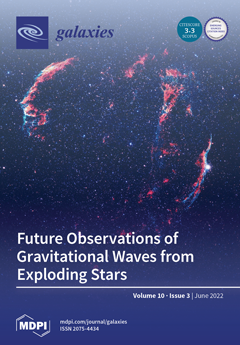Open AccessArticle
Research Facilities for Europe’s Next Generation Gravitational-Wave Detector Einstein Telescope
by
Sibilla Di Pace, Valentina Mangano, Lorenzo Pierini, Amirsajjad Rezaei, Jan-Simon Hennig, Margot Hennig, Daniela Pascucci, Annalisa Allocca, Iara Tosta e Melo, Vishnu G. Nair, Philippe Orban, Ameer Sider, Shahar Shani-Kadmiel and Joris van Heijningen
Cited by 15 | Viewed by 4502
Abstract
The Einstein Telescope is Europe’s next generation gravitational-wave detector. To develop all necessary technology, four research facilities have emerged across Europe: The Amaldi Research Center (ARC) in Rome (Italy), ETpathfinder in Maastricht (The Netherlands), SarGrav in the Sos Enattos mines on Sardinia (Italy)
[...] Read more.
The Einstein Telescope is Europe’s next generation gravitational-wave detector. To develop all necessary technology, four research facilities have emerged across Europe: The Amaldi Research Center (ARC) in Rome (Italy), ETpathfinder in Maastricht (The Netherlands), SarGrav in the Sos Enattos mines on Sardinia (Italy) and E-TEST in Liége (Belgium) and its surroundings. The ARC pursues the investigation of a large cryostat, equipped with dedicated low-vibration cooling lines, to test full-scale cryogenic payloads. The installation will be gradual and interlaced with the payload development. ETpathfinder aims to provide a low-noise facility that allows the testing of full interferometer configurations and the interplay of their subsystems in an ET-like environment. ETpathfinder will focus amongst others on cryogenic technologies, silicon mirrors, lasers and optics at 1550 and 2090 nm and advanced quantum noise reduction schemes. The SarGrav laboratory has a surface lab and an underground operation. On the surface, the Archimedes experiment investigates the interaction of vacuum fluctuations with gravity and is developing (tilt) sensor technology for the Einstein Telescope. In an underground laboratory, seismic characterisation campaigns are undertaken for the Sardinian site characterisation. Lastly, the Einstein Telecope Euregio meuse-rhine Site & Technology (E-TEST) is a single cryogenic suspension of an ET-sized silicon mirror. Additionally, E-TEST investigates the Belgian–Dutch–German border region that is the other candidate site for Einstein Telescope using boreholes and seismic arrays and hydrogeological characterisation. In this article, we describe the Einstein Telescope, the low-frequency part of its science case and the four research facilities.
Full article
►▼
Show Figures





